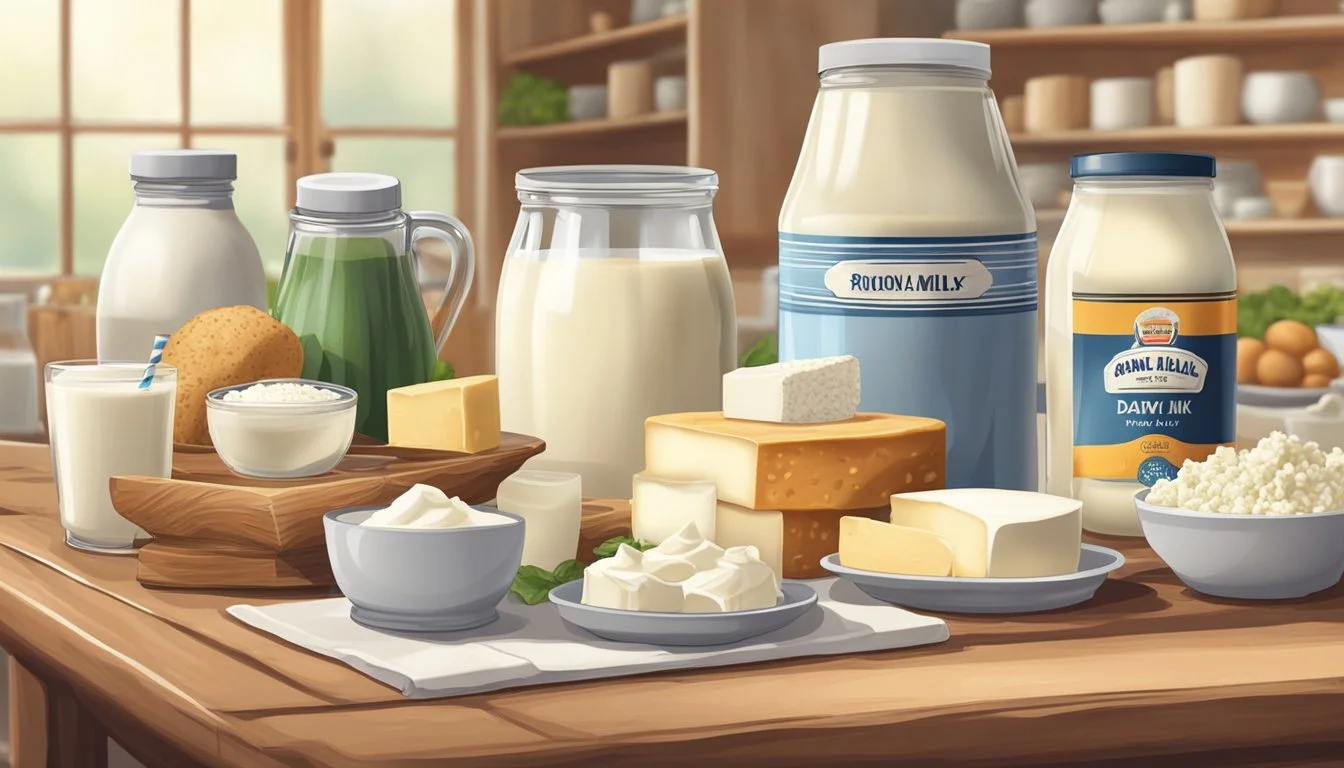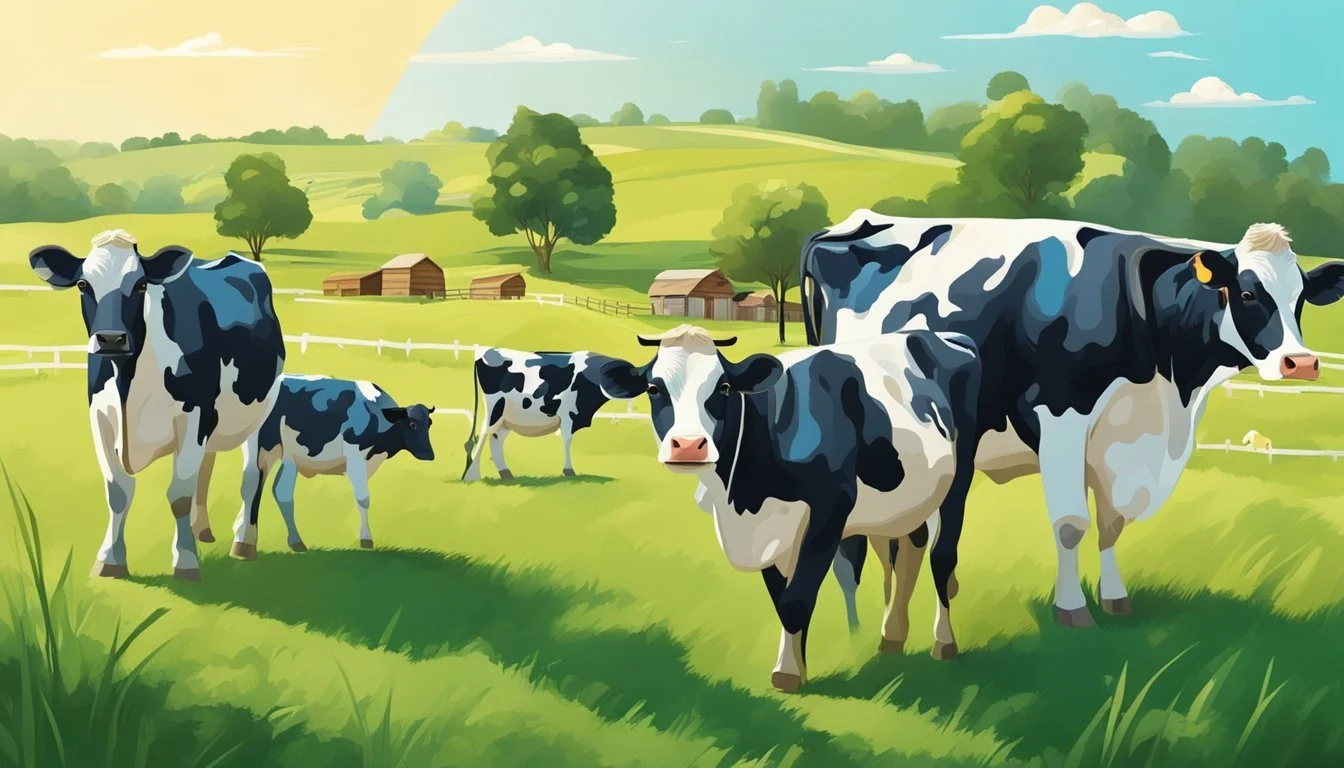Raw Milk Benefits for Seniors
Exploring Health Advantages for the Aging Population
As the global population ages, nutrition becomes an increasingly critical factor for maintaining health and wellbeing among seniors. Raw milk, as a dietary inclusion for the elderly, presents itself with a unique profile of nutrients that could potentially address the specific health concerns of this demographic. It's a source of high-quality protein, essential fats, and a range of vitamins and minerals, including calcium, which is paramount for bone health, a major concern for older adults.
The consumption of raw milk in the aging population offers calories that are important in preventing unintended weight loss—a common issue in the elderly. It also provides a host of other nutrients vital for maintaining physical health and potentially aiding cognitive functions. However, it is crucial to balance potential benefits with safety concerns, especially regarding the risk of foodborne illnesses due to pathogens that can be present in unpasteurized milk.
While there’s ongoing debate about the role of dairy in cognitive maintenance, some studies suggest dairy intake may be linked to better cognitive performance in older adults. Incorporating milk into their diets could be part of a comprehensive nutritional strategy aimed at preserving both physical and mental health as they age. Given the importance of diet in the aging process, understanding the role of foods like raw milk is essential in designing diets that support a healthy and active later life.
Raw milk offers a range of potential benefits for seniors, particularly when sourced from sustainable raw milk farming practices. The consumption of artisanal cheese raw milk can provide seniors with a source of high-quality protein and essential nutrients, contributing to a balanced and nourishing diet. Additionally, the use of raw milk ghee in cooking can add flavor and richness to meals, enhancing the culinary experience for seniors while providing potential nutritional value.
Incorporating raw milk into a whole foods diet can offer seniors a natural and unprocessed source of nourishment, potentially supporting overall well-being. Furthermore, the potential role of raw milk in weight management is a topic of interest, with some seniors finding value in its nutrient density and potential to support their dietary goals.
The politics of raw milk have influenced discussions around its place in senior nutrition, with ongoing debates and advocacy for its consumption. Overall, raw milk can be a positive addition to the diets of seniors, offering potential nutritional benefits and contributing to a wholesome and varied culinary experience.
Understanding Raw Milk
The section delves into the fundamental aspects of raw milk, addressing its definition, comparison with pasteurized milk, and its nutritional content, providing readers with essential insights.
Definition and Types of Raw Milk
Raw milk is the unprocessed milk obtained directly from cows, goats, or sheep before it undergoes any treatment such as pasteurization. There are various types of raw milk, depending on the animal source:
Cow’s Milk: The most common type, known for its rich flavor and nutritional value.
Goat’s Milk: Easier to digest with distinct taste, often preferred by those with lactose sensitivities.
Sheep’s Milk: Higher in fat and protein compared to cow and goat milk; less commonly found.
Raw Milk vs. Pasteurized Milk: The Key Differences
The primary difference between raw milk and pasteurized milk is the treatment process each undergoes. Pasteurization involves heating milk to destroy potentially harmful bacteria and other pathogens. In contrast, raw milk is not pasteurized, which proponents claim retains beneficial nutrients and enzymes that pasteurization might destroy.
Raw Milk Pasteurized Milk Process None Heated to kill bacteria Nutrition May contain more enzymes and microorganisms Nutrients can be reduced by heat Shelf Life Shorter due to lack of processing Longer due to bacteria being killed Regulations Sales are highly regulated or prohibited in some areas Widely legal and available
Nutritional Profile of Raw Milk
Raw milk offers a rich nutritional profile, containing a variety of vitamins, minerals, and enzymes. Some key components of the nutritional value include:
Calcium: Vital for bone health and muscle function.
Vitamins: A wide range, including vitamins A, D, and B complex.
Enzymes: Believed to aid in digestion and nutrient absorption.
Proteins and Fats: Essential for growth, maintenance, and energy.
The nutritional content can vary based on the animal source, diet, and overall health. However, it is essential to note that raw milk can also pose health risks due to the potential presence of pathogens that are otherwise eliminated through pasteurization.
Health Benefits of Raw Milk for Seniors
Raw milk, a source of essential nutrients, can be particularly beneficial for seniors, assisting with immune support, bone health, muscle maintenance, and digestive wellness.
Nutrients Essential for Aging Bodies
Raw milk is rich in high-quality protein and calcium, which are crucial for seniors. The protein in raw milk aids in the repair and maintenance of tissues, while calcium is vital for maintaining bone density. Additionally, raw milk provides a spectrum of vitamins and minerals that support overall health.
Role of Raw Milk in Strengthening the Immune System
The consumption of raw milk may support the immune system due to its bioavailable nutrients and immunoglobulins. These components can help elderly individuals fight off infections and stay healthy.
Supporting Muscle Mass and Bone Health
As individuals age, the risk of sarcopenia, or age-related muscle loss, increases. The protein and calcium found in raw milk are fundamental in combating this condition, as they are key in preserving muscle mass and bone health.
Enhancing Digestive Wellness
Seniors may encounter digestive symptoms more frequently. Raw milk contains enzymes that may facilitate digestion, helping to alleviate digestive discomfort and promote overall gut health.
Potential Risks and Considerations
The consumption of raw milk by the aging population can carry certain risks due to the increased possibility of foodborne illnesses and sensitivity to allergens. It is crucial to weigh these factors carefully when considering raw milk in seniors' diets.
Concerns Over Foodborne Illnesses
Raw milk is unpasteurized, and therefore, it can contain harmful bacteria such as Salmonella, E. coli, and Listeria. These bacteria can cause severe foodborne illnesses, which are particularly dangerous for older adults with compromised immune systems. The risk of contamination is heightened as the milk lacks the heat treatment that eliminates pathogens in pasteurized milk.
Lactose Intolerance and Allergies
Lactose intolerance: An inability to digest lactose due to lower levels of lactase enzyme can cause discomfort for many seniors, leading to symptoms such as bloating, gas, and abdominal pain.
Allergies: Milk proteins can cause allergic reactions in some individuals. Symptoms can range from mild to life-threatening and may include rash, hives, and anaphylaxis.
Safe Consumption Practices
To mitigate the risks of consuming raw milk, strict adherence to safe handling and storage practices is essential. Seniors should be advised to:
Store milk at temperatures below 40°F (4°C).
Consume milk before its expiration date.
Recognize and heed the signs of spoiling, such as off-odor and separation.
By understanding and applying these considerations, the aging population can make more informed choices regarding the incorporation of raw milk into their diets.
Comparison with Other Dairy and Non-Dairy Alternatives
In addressing the nutritional needs of the aging population, it's crucial to understand how raw milk compares with other dairy and non-dairy alternatives in terms of lactose content and overall nutrition, especially when considering options for those who are lactose intolerant.
Milk Alternatives for the Lactose Intolerant
For seniors who are lactose intolerant, various non-dairy milk alternatives exist, such as soy, almond, rice, oat, coconut, and flax milk. These products are naturally free from lactose, the sugar found in cow's milk that requires the enzyme lactase for digestion. Without sufficient lactase, lactose can cause digestive discomfort, hence the consideration of these alternatives.
Soy milk: Offers a comparable protein content to dairy, beneficial for muscle maintenance in seniors.
Almond and rice milk: Lower in protein, which might necessitate additional protein sources in one's diet.
Oat milk: Valued for its fiber content which supports digestive health, but often lower in protein.
Coconut milk: Rich in medium-chain triglycerides, which may aid in maintaining healthy cholesterol levels but is also lower in protein and calcium unless fortified.
Flax milk: Contains omega-3 fatty acids that can contribute to heart health but typically has minimal protein content.
Nutritional Comparison: Raw Milk vs. Plant-Based Milks
Raw milk from cows contains protein, calcium, and vitamin D and may provide a naturally occurring balance of nutrients such as beneficial bacteria, enzymes, and hormones that some believe are advantageous for seniors.
Here's a basic nutritional comparison of raw milk to common plant-based milks, assuming the alternatives are fortified adequately:
Nutrient Raw Cow's Milk Soy Milk Almond Milk Rice Milk Oat Milk Coconut Milk Flax Milk Protein (g) 8 7-8 1-2 1 2-4 0-1 0-1 Calcium (mg) 300 300-450 300-450 300-450 300-450 300-450 300-450 Vitamin D (IU) Variable* 100-144 100-144 100-144 100-144 100-144 100-144
*The vitamin D content in raw cow's milk can be variable, as it depends on the cow's exposure to sunlight and diet. Plant-based milks are generally fortified to have a consistent vitamin D content.
In summary, while each alternative offers its own benefits, they often fall short of raw milk when it comes to natural protein content. Nevertheless, for lactose-intolerant seniors, these fortified milks provide a viable alternative that can be tailored to meet dietary needs, addressing concerns such as protein and calcium deficiency.
Scientific Research and Studies
Extensive scientific research has been conducted to explore the relationship between raw milk consumption and health outcomes for the aging population. Studies particularly focus on the nutritional benefits and potential impacts on aging-related conditions.
Meta-Analysis of Raw Milk Consumption and Health
Meta-analyses provide a higher level of evidence by combining results from multiple studies to identify patterns and make broader conclusions. Studies have examined the effects of raw milk intake on various health outcomes. For instance, a meta-analysis can systematically review the connection between milk consumption and cognitive function. Specifically, cognitive decline, a common concern in older adults, may be influenced by the nutritional properties of raw milk.
Impact of Raw Milk on Aging-Related Conditions
The consumption of raw milk has also been linked to potential impacts on several aging-related conditions. Some studies suggest that raw milk can offer benefits that may:
Reduce the risk of certain cancers due to its unique nutrients.
Influence blood pressure with bioactive compounds that can help in its regulation.
Affect mortality and obesity rates, although evidence is variable and must be interpreted with caution.
Research into the precise effects of raw milk on nutrition and various health problems is ongoing, and understanding its role in maintaining health during aging is critical. However, it is important to note that the consumption of raw milk also poses health risks due to the potential presence of harmful bacteria and pathogens.
Regulatory and Legal Aspects
The regulatory and legal frameworks surrounding raw milk are complex and vary significantly by region. These laws often reflect public health concerns, such as preventing bovine tuberculosis and other diseases.
Raw Milk Legislation Across Different Regions
In the United States, the regulation of raw milk is determined at the state level, leading to a patchwork of varying legal standings. Some states allow for sales of raw milk directly to consumers, while others only permit sales for pet consumption or disallow sales altogether. The USDA does not regulate raw milk at the federal level for human consumption, but it supports pasteurization to kill harmful bacteria.
Internationally, the approach to raw milk can differ substantially. In Australia, the sale of raw milk for human consumption is illegal. However, products like raw milk cheeses are allowed under strict regulations. These cheeses must be aged for a minimum of 60 days to reduce health risks.
Key Differences in Regulation:
United States: Sales regulated by individual states; some allow direct sales to consumers.
Australia: Raw milk sales illegal; certain raw milk cheeses allowed.
Role of Food Safety Agencies
Food safety agencies, such as the FDA in the United States, play a critical role in setting guidelines for milk processing to ensure public health. The FDA endorses pasteurization as the primary method to ensure milk safety, which effectively reduces the risk of transmission of pathogens.
Pasteurization, heating milk to a specific temperature for a set duration, removes harmful microorganisms without significantly changing the nutritional value of the milk. Agencies like the FDA abide by the principle that all milk intended for human consumption should be pasteurized, though this is not mandated at the federal level. To provide alternatives to raw milk, Ultra-High Temperature (UHT) processing offers a shelf-stable product that is also free of harmful microorganisms.
Food Safety Agency Objectives:
Set Processing Guidelines: To ensure the safety of dairy products through methods like pasteurization.
Promote Public Health: By reducing the risk of milk-borne illnesses through regulated processing standards.
Entities like the FDA contend with the challenge of balancing consumer choice with public health. While these agencies acknowledge that homogenized and pasteurized milk remains the standard for safety, they continue to monitor and regulate the dairy industry to safeguard against health risks associated with the consumption of raw dairy products.
Consumer Insights
The aging population displays distinct preferences with a strong inclination towards health and quality-focused food choices. These preferences shape the demand for raw milk and align with trust in natural, less processed products.
Preferences and Consumers’ Trust
Consumers, specifically older Americans, generally tend to prioritize health when selecting food products. They show a marked preference for raw milk due to its perceived freshness and natural qualities. The taste of raw milk, often described as richer and more complex, also appeals to those preferring unadulterated flavors. However, trust is pivotal; seniors exhibit a strong sense of loyalty toward brands and sources known for high-quality and safe practices in their raw milk production.
Demand for Local and Unprocessed Products
Demand among senior consumers for local and unprocessed products is on the rise. They typically associate local products with freshness and contribute to community support, which is a compelling factor for this demographic. The preference for unprocessed, or minimally processed, items is driven by the belief in their nutritional superiority and aligns with their desire for wholesome dietary intake. Products like raw milk from local dairies are sought after by those who emphasize a natural diet free from extensive processing.
Environmental and Ethical Considerations
When examining the environmental and ethical aspects of raw milk production, especially regarding the aging population, it's essential to scrutinize sustainable farming practices and animal welfare.
Sustainable Farming and Animal Welfare
The production of raw milk must prioritize sustainable farming practices that mitigate environmental impacts. This involves managing dairy farms in a manner that reduces greenhouse gas emissions and promotes the well-being of local ecosystems. Smaller, local farms often employ methods that are more favorable to the environment, such as rotational grazing, which can help maintain soil health and biodiversity.
In terms of animal welfare, ethical considerations focus on the treatment of cows. Practices that ensure high standards of welfare, such as providing clean living conditions, adequate space, and proper veterinary care, are indications of an ethically-run dairy farm. The stress and health of dairy cows can directly influence the quality and safety of the milk produced, making this a significant concern for consumers, particularly seniors who may be more susceptible to foodborne illnesses.
By emphasizing these ethical and environmental concerns, the production of raw milk can align with broader goals of sustainability and humane animal treatment, ultimately contributing to a responsible way forward for dairy consumption among the aging population.
Conclusion
Raw milk consumption among the elderly can be a source of essential nutrients. They often require higher nutritional content to maintain health, and raw milk provides calcium, important for bone health, and may aid in maintaining muscle function and preventing involuntary weight loss.
However, they must consider the potential risks associated with raw milk, which include exposure to harmful bacteria that can lead to serious illnesses. Seniors often have weakened immune systems, making them more susceptible to foodborne illnesses.
For those considering adding raw milk to their diets, it is critical to source it from credible, hygienic sources with proven safety practices. Here is a summary:
Nutritional Benefits:
High in calcium and protein
May support weight maintenance
Could aid cognitive function
Potential Risks:
Risk of foodborne illness
Potential for lactose intolerance issues
Requires reliable sourcing to minimize health risks
Given the benefits and risks, the decision to consume raw milk should be made with careful consideration and ideally, in consultation with a healthcare provider. It is imperative that the elderly population, their caregivers, and health professionals weigh the nutritional advantages against the safety concerns to make informed decisions tailored to individual health needs and conditions.






